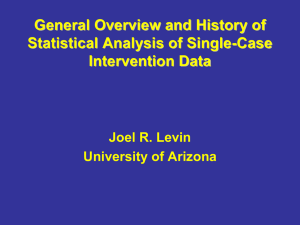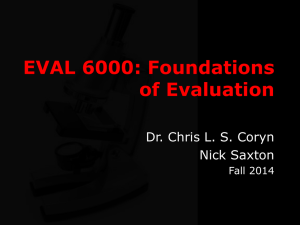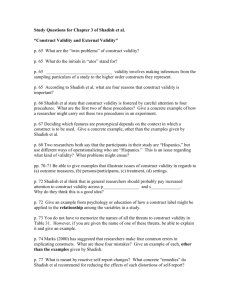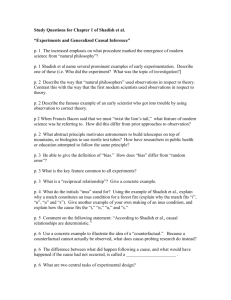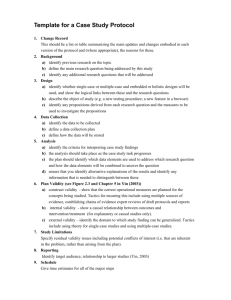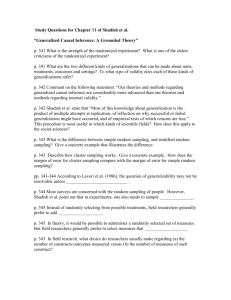Levin, Joel – Brief Comments on Single
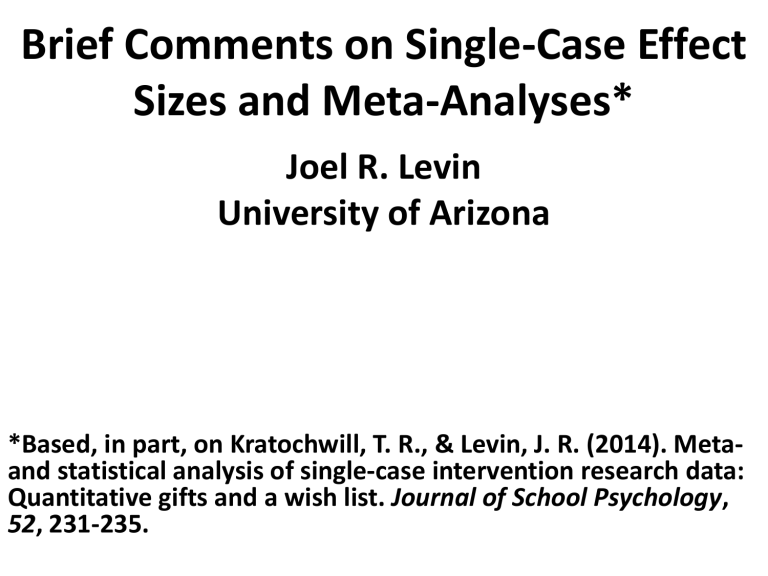
Brief Comments on Single-Case Effect
Sizes and Meta-Analyses*
Joel R. Levin
University of Arizona
*Based, in part, on Kratochwill, T. R., & Levin, J. R. (2014). Metaand statistical analysis of single-case intervention research data:
Quantitative gifts and a wish list. Journal of School Psychology,
52, 231-235.
Opening Remarks
Kudos to Shadish, Hedges, Rindskopf, and the gang!
Distinction to be made here (following Levin &
Robinson, 2003) :
Single-study decision-oriented research vs.
Multiple-study syntheses
Akin to Abelson’s (1997) “lore” vs. record”
Preaching to the Choir?
“It is not that standardizing an effect size within case is wrong. Indeed, SCD research needs effect sizes that are computed within case. The reason is that most SCD researchers are trained, and train their students, to examine each case individually, one case at a time. A study-wide summary over cases is not useful for that purpose, as useful as it may be for other purposes. SCD research needs to continue both approaches to effect size computation.”
Shadish, Hedges, & Pustejovsky (2013)
Possible Single-Study Effect-Size Measures
Nonoverlap measures (e.g., Parker, Vannest, & Davis, 2014)
Other “common language” (McGraw & Wong, 1992) measures:
Percent increase/decrease
Change in pre-established classification criteria
Add Cohen-type exclamatory modifiers, if wanted — for example, the following WRDs:
“ Wow!
” for data passing the IOTT
“ Respectable ” for moderate-looking effects
“ Darn!
” for weak or statistically nonsignificant effects
Uncommon (esoteric) language measures:
Regression-based measures (e.g., Ross & Begeny, 2014)
Percent of variance “explained” by the intervention
Mean phase difference in standard deviation units (d)
Shadish et al.’s (2004) d and g
Effect-Size Measures
Consider a single N = 1 study:
Tasky et al. (2008) Data (Participant 1)
[From Shadish et al., 2014, Appendix, pp. 552-553]
Shadish et al.’s (2004) d and g
Effect-Size Measures
Consider a single N = 2 study:
Tasky et al. (2008) Data (Participants 1 and 2)
[From Shadish et al., 2014, Appendix, pp. 552-553]
Busk &Serlin’s (1992) Average d = 0.93
Shadish et al.’s (2004) d and g
Effect-Size Measures
Consider a single N = 3 study:
Tasky et al. (2008) Data (Participants 1, 2, and 3)
(From Shadish et al., 2014, Appendix, pp. 552-553)
Busk &Serlin’s (1992) Average d = ?
Shadish et al.’s (2014) d = ?
(g = ?
)
Now, to illustrate an aspect of Shadish et al’s d that might be troubling to certain single-case intervention researchers, consider the following pair of AB design examples, each based on 3 units and 30 randomly generated outcome observations with an autocorrelation of .40. [Thanks again to John Ferron!]
Example 1:
O
A
(μ
B
= 15, N (49, 100); O
B
- μ
A
)/σ
A
= 15, N (55, 100); Δ =
= .60 for each unit.
d Effect-Size Visual Analysis Example 1
(A Means and Effect Sizes, the “same” for all Units)
Average Effect Size d = 0.57
Example 2:
O
1A
(μ
B
= 15, N (57, 100); O
1B
- μ
A
)/σ
A
= .60.
= 15, N (63, 100); Δ =
O
2A
(μ
B
= 15, N (49, 100); O
2B
- μ
A
)/σ
A
= .60.
= 15, N (55, 100); Δ =
O
3A
(μ
B
= 15, N (41, 100); O
3B
- μ
A
)/σ
A
= .60.
= 15, N (47, 100); Δ =
d Effect-Size Visual Analysis Example 2
(A Means different for all units; Effect Sizes the
Same as in Example 1)
Average Effect Size d = 0.57
A Concluding Question to Ponder
Do we really need a mathematically unifying single-case effect-size measure such as Shadish et al.’s d?
1. For meta-analysts who seek to combine effect sizes from “group” and single-case intervention studies: Yes , but maybe separate meta-analyses and associated measures should be provided for the two study types.
2. For single-case researchers with their stand-alone studies: perhaps No . If not, are there certain measures that can be recommended because they make the most conceptual and practical sense? And are there other measures that should be dismissed because they don’t?
References
Abelson, R. P. (1997). A retrospective on the significance test ban of 1999 (If there were no significance tests, they would be invented). In L. L. Harlow, S. A. Mulaik,
& J. H. Steiger (Eds.). What if there were no significance tests? (pp. 118-141).
Mahwah, NJ: Erlbaum.
Busk, P. L., & Serlin, R. C. (1992). Meta-analysis for single-case research. In T. R.
Kratochwill & J. R. Levin (Eds.), Single-case research design and analysis (pp. 187-
212). Hillsdale, NJ: Erlbaum.
Levin, J. R., & Robinson, D. H. (2003). The trouble with interpreting statistically nonsignificant effect sizes in single-study investigations. Journal of Modern
Applied Statistical Methods, 2, 231-236.
McGraw, K. O., & Wong, S. P. (1992). A common language effect size statistic.
Psychological Bulletin, 111, 361-365.
Parker, R. I., Vannest, K. J., & Davis, J. L. (2014) Non-overlap analysis for single-case research. In T. R. Kratochwill & J. R. Levin (eds.). (0214). Single-case intervention
research: Methodological and statistical advances (pp. 127-151). Washington,
DC: American Psychological Association.
Ross, S. G., & Begeny, J. C. (2014). Single-case effect size calculation: Comparing regression and non-parametric approaches across previously published reading intervention data sets. Journal of School Psychology, 52, 419-431.
Shadish, W. R., Hedges, L. V., & Pustejovsky, J. E. (2013). Analysis and meta-analysis of single-case designs with a standardized mean difference statistic: A primer and applications. Journal of School Psychology, 52, 123-147.
Shadish, W. R., Hedges, L. V., Pustejovsky, J. E., Boyajian, J. G., Sullivan, K. J.,
Andrade, A., & Barrientos, J. L. (2014). A d-statistic for single-case designs that is equivalent to the usual between-groups d-statistic. Neuropsychological
Rehabilitation, 24, 529-553.
